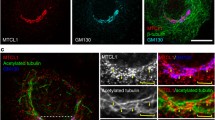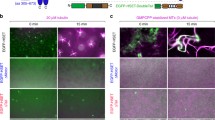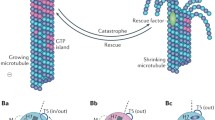Abstract
It has long been known that the interphase microtubule (MT) array is a key cellular scaffold that provides structural support and directs organelle trafficking in eukaryotic cells. Although in animal cells, a combination of centrosome nucleating properties and polymer dynamics at the distal microtubule ends is generally sufficient to establish a radial, polar array of MTs, little is known about how effector proteins (motors and crosslinkers) are coordinated to produce the diversity of interphase MT array morphologies found in nature. This diversity is particularly important in multinucleated environments where multiple MT arrays must coexist and function. We initiate here a study to address the higher ordered coordination of multiple, independent MT arrays in a common cytoplasm. Deletion of a MT crosslinker of the MAP65/Ase1/PRC1 family disrupts the spatial integrity of multiple arrays in Dictyostelium discoideum, reducing the distance between centrosomes and increasing the intermingling of MTs with opposite polarity. This result, coupled with previous dynein disruptions suggest a robust mechanism by which interphase MT arrays can utilize motors and crosslinkers to sense their position and minimize overlap in a common cytoplasm.










Similar content being viewed by others
References
Bornens M (2012) The centrosome in cells and organisms. Science 335(6067):422–426
Holy TE, Dogterom M, Yurke B, Leibler S (1997) Assembly and positioning of microtubule asters in microfabricated chambers. Proc Natl Acad Sci (USA) 94(12):6228–6231
Malikov V, Cytrynbaum EN, Kashina A, Mogilner A, Rodionov V (2005) Centering of a radial microtubule array by translocation along microtubules spontaneously nucleated in the cytoplasm. Nat Cell Biol 7(12):1213–1218
McNally FJ (2013) Mechanisms of spindle positioning. J Cell Biol 200(2):131–140
Dawe HR, Farr H, Gull K (2007) Centriole/basal body morphogenesis and migration during ciliogenesis in animal cells. J Cell Sci 120(1):7–15
Gundersen GG, Worman HJ (2013) Nuclear positioning. Cell 152(6):1376–1389
Laan L, Pavin N, Husson J, Romet-Lemonne G, van Duijn M, López M, Vale RD, Jülicher F, Reck-Peterson SL, Dogterom M (2012) Cortical dynein controls microtubule dynamics to generate pulling forces that position microtubule asters. Cell 148(3):502–514
Mavrakis M, Rikhy R, Lippincott-Schwartz J (2009) Cells within a cell: insights into cellular architecture and polarization from the organization of the early fly embryo. Commun Integr Biol 2(4):313–314
Chan J, Jensen CG, Jensen LCW, Bush M, Lloyd CW (1999) The 65-kDa carrot microtubule-associated protein forms regularly arranged filamentous cross-bridges between microtubules. Proc Natl Acad Sci (USA) 96(26):14931–14936
Loiodice I, Staub J, Setty TG, Nguyen NP, Paoletti A, Tran PT (2005) Ase1p organizes antiparallel microtubule arrays during interphase and mitosis in fission yeast. Mol Bio Cell 16(4):1756–1768
Mollinari C, Kleman J-P, Jiang W, Schoehn G, Hunter T, Margolis RL (2002) PRC1 is a microtubule binding and bundling protein essential to maintain the mitotic spindle midzone. J Cell Biol 157(7):1175–1186
Schuyler SC, Liu JY, Pellman D (2003) The molecular function of Ase1p: evidence for a MAP-dependent midzone-specific spindle matrix. J Cell Biol 160(4):517–528
Koonce MP, Khodjakov A (2002) Dynamic microtubules in Dictyostelium. J Muscle Res Cell Motil 23(7–8):613–619
Duleh SN, Collins JTB, Pope RK (2005) Morphological and functional analysis of Rac1B in Dictyostelium discoideum. J Electron Microscopy 54(6):519–528
Fukui Y, De Lozanne A, Spudich JA (1990) Structure and function of the cytoskeleton of a Dictyostelium myosin-defective mutant. J Cell Biol 110(2):367–378
Gräf R, Euteneuer U, Ho T-H, Rehberg M (2003) Regulated expression of the centrosomal protein DdCP224 affects microtubule dynamics and reveals mechanisms for the control of supernumerary centrosome number. Mol Biol Cell 14(10):4067–4074
Neujahr R, Albrecht R, Kohler J, Matzner M, Schwartz JM, Westphal M, Gerisch G (1998) Microtubule-mediated centrosome motility and the positioning of cleavage furrows in multinucleate myosin II-null cells. J Cell Sci 111(9):1227–1240
Brito DA, Strauss J, Magidson V, Tikhonenko I, Khodjakov A, Koonce MP (2005) Pushing forces drive the comet-like motility of microtubule arrays in Dictyostelium. Mol Biol Cell 16(7):3334–3340
Hestermann A, Gräf R (2004) The XMAP215-family protein DdCP224 is required for cortical interactions of microtubules. BMC Cell Biol 5:24
Koonce MP, Kohler J, Neujahr R, Schwartz JM, Tikhonenko I, Gerisch G (1999) Dynein motor regulation stabilizes interphase microtubule arrays and determines centrosome position. EMBO J 18(23):6786–6792
Rehberg M, Kleylein-Sohn J, Faix J, Ho TH, Schulz I, Gräf R (2005) Dictyostelium LIS1 is a centrosomal protein required for microtubule/cell cortex interactions, nucleus/centrosome linkage, and actin dynamics. Mol Biol Cell 16(6):2759–2771
Basu S, Fey P, Pandit Y, Dodson R, Kibbe WA, Chisholm RL (2013) DictyBase 2013: integrating multiple Dictyostelid species. Nucleic Acids Res 41(D1):D676–D683
Jiang W, Jimenez G, Wells NJ, Hope TJ, Wahl GM, Hunter T, Fukunaga R (1998) PRC1: a human mitotic spindle–associated CDK substrate protein required for cytokinesis. Mol Cell 2:877–885
Yamashita A, Sato M, Fujita A, Yamamoto M, Toda T (2005) The roles of fission yeast Ase1 in mitotic cell division, meiotic nuclear oscillation, and cytokinesis checkpoint signaling. Mol Biol Cell 16(3):1378–1395
Koonce MP, Samsó M (1996) Overexpression of cytoplasmic dynein’s globular head causes a collapse of the interphase microtubule network in Dictyostelium. Mol Biol Cell 7(6):935–948
Ma S, Triviños-Lagos L, Gräf R, Chisholm RL (1999) Dynein intermediate chain mediated dynein–dynactin interaction is required for interphase microtubule organization and centrosome replication and separation in Dictyostelium. J Cell Biol 147(6):1261–1274
Verbrugghe KJC, White JG (2004) SPD-1 is required for the formation of the spindle midzone but is not essential for the completion of cytokinesis in C. elegans embryos. Curr Biol 14(19):1755–1760
Vernì F, Somma MP, Gunsalus KC, Bonaccorsi S, Belloni G, Goldberg ML, Gatti M (2004) Feo, the Drosophila homolog of PRC1, is required for central-spindle formation and cytokinesis. Curr Biol 14(17):1569–1575
Lee K-Y, Esmaeili B, Zealley B, Mishima M (2015) Direct interaction between centralspindlin and PRC1 reinforces mechanical resilience of the central spindle. Nat Commun 6:7290
Aist JR, Berns MW (1981) Mechanics of chromosome separation during mitosis in Fusarium (Fungi imperfecti): new evidence from ultrastructural and laser microbeam experiments. J Cell Biol 91:446–458
Pellman D, Bagget M, Tu YH, Fink GR, Tu H (1995) Two microtubule-associated proteins required for anaphase spindle movement in Saccharomyces cerevisiae. J Cell Biol 130(6):1373–1385
Waters JC, Cole RW, Rieder CL (1993) The force-producing mechanism for centrosome separation during spindle formation in vertebrates is intrinsic to each aster. J Cell Biol 122:361–372
Ho C-MK, Hotta T, Guo F, Roberson RW, Lee Y-RJ, Liu B (2011) Interaction of antiparallel microtubules in the phragmoplast is mediated by the microtubule-associated protein MAP65-3 in Arabidopsis. Plant Cell 23(8):2909–2923
Lucas JR, Courtney S, Hassfurder M, Dhingra S, Bryant A, Shaw SL (2011) Microtubule-associated proteins MAP65-1 and MAP65-2 positively regulate axial cell growth in etiolated Arabidopsis hypocotyls. Plant Cell 23:1889–1903
Janson ME, Loughlin R, Loïodice I, Fu C, Brunner D, Nédélec FJ, Tran PT (2007) Crosslinkers and motors organize dynamic microtubules to form stable bipolar arrays in fission yeast. Cell 128(2):357–368
Anderson CA, Eser U, Korndorf T, Borsuk ME, Skotheim JM, Gladfelter AS (2013) Nuclear repulsion enables division autonomy in a single cytoplasm. Curr Biol 23(20):1999–2010
Nguyen PA, Groen AC, Loose M, Ishihara K, Wühr M, Field CM, Mitchison TJ (2014) Spatial organization of cytokinesis signaling reconstituted in a cell-free system. Science 346(6206):244–247
Nag DK, Tikhonenko I, Soga I, Koonce MP (2008) Disruption of four kinesin genes in Dictyostelium. BMC Cell Biol 9:21
Bieling P, Telley IA, Surrey T (2010) A minimal midzone protein module controls formation and length of antiparallel microtubule overlaps. Cell 142(3):420–432
Hu C-K, Coughlin M, Field CM, Mitchison TJ (2011) Kif4 regulates midzone length during cytokinesis. Curr Biol 21:815–824
Su X, Arellano-Santoyo H, Portran D, Gaillard J, Vantard M, Thery M, Pellman D (2013) Microtubule-sliding activity of a kinesin-8 promotes spindle assembly and spindle-length control. Nat Cell Biol 15(8):948–957
Subramanian R, Ti S-C, Tan L, Darst SA, Kapoor TM (2013) Marking and measuring single microtubules by PRC1 and kinesin-4. Cell 154(2):377–390
Glunčić M, Maghelli N, Krull A, Krstić V, Ramunno-Johnson D, Pavin N, Tolić IM (2015) Kinesin-8 motors improve nuclear centering by promoting microtubule catastrophe. Phy Rev Lett 114(7):078103
Kurasawa Y, Earnshaw WC, Mochizuki Y, Dohmae N, Todokoro K (2004) Essential roles of KIF4 and its binding partner PRC1 in organized central spindle midzone formation. EMBO J 23(16):3237–3248
Egelhoff TT, Titus MA, Manstein DJ, Ruppel KM, Spudich JA (1991) Molecular genetic tools for study of the cytoskeleton in Dictyostelium. In: Vallee RB (ed) Methods in enzymology, vol 196. Academic Press, Amsterdam, pp 319–334
Koonce MP, McIntosh JR (1990) Identification and immunolocalization of cytoplasmic dynein in Dictyostelium. Cell Motil Cytoskel 15(1):51–62
Tikhonenko I, Nag DK, Martin N, Koonce MP (2008) Kinesin-5 is not essential for mitotic spindle elongation in Dictyostelium. Cell Motil Cytoskel 65(11):853–862
Ueda M, Gräf R, MacWilliams HK, Schliwa M, Euteneuer U (1997) Centrosome positioning and directionality of cell movements. Proc Natl Acad Sci USA 94(18):9674–9678
Koonce MP, Grissom PM, Lyon M, Pope T, McIntosh JR (1994) Molecular characterization of a cytoplasmic dynein from Dictyostelium. J Eukaryot Microbiol 41(6):645–651
Tikhonenko I, Magidson V, Gräf R, Khodjakov A, Koonce MP (2013) A kinesin-mediated mechanism that couples centrosomes to nuclei. Cell Mol Life Sci 70:1285–1296
Dubin M, Fuchs J, Gräf R, Schubert I, Nellen W (2010) Dynamics of a novel centromeric histone variant CenH3 reveals the evolutionary ancestral timing of centromere biogenesis. Nucleic Acid Res 38(21):7526–7537
Sikirzhytski V, Magidson V, Steinman JB, He J, Le Berre M, Tikhonenko I, Ault JG, McEwen BF, Chen JK, Sui H, Piel M, Kapoor TM, Khodjakov A (2014) Direct kinetochore–spindle pole connections are not required for chromosome segregation. J Cell Biol 206(2):231–243
Schulz I, Reinders Y, Sickmann A, Gräf R (2006) An improved method for Dictyostelium centrosome isolation. Methods Mol Biol 346:479–489
Tikhonenko I, Nag DK, Robinson DN, Koonce MP (2009) Microtubule-nucleus interactions in Dictyostelium discoideum mediated by central motor kinesins. Eukaryot Cell 8(5):723–731
Acknowledgments
We appreciate the use of Wadsworth Center’s Molecular Genetics Core for DNA sequencing. We thank Dr. Wolfgang Nellen for kindly providing the GFP-CenH3 expression plasmid, Dr. Manfred Schliwa for the GFP-γ-tubulin construct, Valentin Magidson for general light microscopy assistance, and Dr. Vitali Sikirzhytski for help with statistical analysis. We are grateful to the efforts at http://dictybase.org to archive and annotate Dictyostelium sequence information. This work was supported in part by the NSF (MCB-1051612 to M.P.K, DBI-1062963 for REU support of K.I), and the NIH (GM59363 to A.K).
Author information
Authors and Affiliations
Corresponding author
Ethics declarations
Ethical standards
The experiments presented in this manuscript submitted for publication were performed in compliance with the current laws of the United States.
Conflict of interest
The authors declare that they have no conflict of interest.
Electronic supplementary material
Below is the link to the electronic supplementary material.
18_2015_2026_MOESM1_ESM.tif
Supplemental Fig. 1. Targeted disruption of Ase1 isoforms by homologous recombination. The schematics in A diagram the strategy used to target insertion of a blasticidin S resistance cassette and disrupt gene transcription of Ase1A and Ase1B. Arrows show position of PCR primers used to screen clones for targeted inserts. Figure inserts show RT-PCR reactions in WT and KO strains. While ample message can be detected in WT cells, no gene products are seen in the Ase1A− or B− strains. Panel B shows growth curves of WT, Ase1A− and Ase1B− cells. (TIFF 2850 kb)
18_2015_2026_MOESM3_ESM.tif
Supplemental Fig. 2. Centromeres rapidly segregate during division in Ase1A− cells. Sequential frames (20 s interval) of a cell labeled with the centromere marker, GFP-DdCenH3 [51]. Centromere clusters separate here at a rate comparable to the fast centrosome movements quantified in Fig. 4. Bar = 5 μm. (TIFF 88 kb)
18_2015_2026_MOESM4_ESM.tif
Supplemental Fig. 3. Amplitude Spectrum of intercentrosome distance in WT vs. Ase1A− cells. Quantitation of movement between centrosome pairs, as presented in Fig. 6. Distance and frequency of 11 WT and 14 Ase1A− pairs were measured using a Fourier transform in a MATLAB environment. The trendlines are fitted to a cubic polynomial Eq. 1 px = 107 nm. (TIFF 2653 kb)
18_2015_2026_MOESM5_ESM.tif
Supplemental Fig. 4. Immunoblot of soluble Ase1A. Left panel shows Coomassie-stained PAGE lanes of supernatant and pellet following cell lysis and nuclear sedimentation. Middle and right panels show immunoblots from the same samples probed with an antibody against GFP. The left blot is from cells expressing the ~ 116 kDa GFP-Ase1A fusion; the right blot is from cells expressing ~ 95 kDa GFP-histone H3 like variant (Sup Fig. 2, [51]). The arrowhead points out a trace amount of Ase1A that is present in the supernatant, while the bulk of the polypeptide copellets with intact nuclei. The H3v1 samples are provided to control for potential nuclear breakage; no H3v1 fusion product is detected in the soluble fraction. (TIFF 10777 kb)
18_2015_2026_MOESM6_ESM.tif
Supplemental Fig. 5. MT disorganization in kinesin-4− cells. The left two panels show interphase binucleate cells where the Dd kinesin-4 family isoform (kif8) has been deleted [38]. Note a similar disorganization to the MT patterns as in Ase1A deletion. The two right panels show mitotic cells, demonstrating that a proper spindle forms in the absence of this kinesin. Bar = 10 μm (TIFF 495 kb)
Rights and permissions
About this article
Cite this article
Tikhonenko, I., Irizarry, K., Khodjakov, A. et al. Organization of microtubule assemblies in Dictyostelium syncytia depends on the microtubule crosslinker, Ase1. Cell. Mol. Life Sci. 73, 859–868 (2016). https://doi.org/10.1007/s00018-015-2026-8
Received:
Revised:
Accepted:
Published:
Issue Date:
DOI: https://doi.org/10.1007/s00018-015-2026-8




